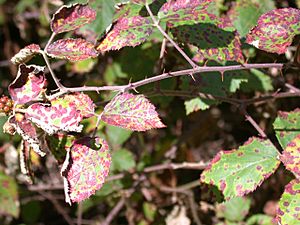Phragmidium violaceum facts for kids
Quick facts for kids Phragmidium violaceum |
|
|---|---|
 |
|
| Blackberry plants infected with rust fungus, a biological control agent for blackberry. The newly released strains of the European blackberry rust fungus (Phragmidium violaceum) are highly host-specific for weedy blackberries. | |
| Scientific classification | |
| Genus: |
Phragmidium
|
| Species: |
violaceum
|
| Synonyms | |
|
|
Phragmidium violaceum is a tiny living thing that causes diseases in plants. It is a type of fungus that comes from Europe, Africa, and the Middle East. This fungus mostly infects plants in the Rubus group, like blackberry bushes.
How it Helps Control Weeds
This fungus has been used to help control invasive blackberry plants in countries like Chile, Australia, and New Zealand. This is a method called biological control. It means using one living thing (like this fungus) to control another living thing (like a weed).
In 2005, Phragmidium violaceum was found growing on Himalayan blackberry plants in Oregon, USA. This happened by accident. Luckily, it seems this fungus is not harming native plants in the area. This gives hope that it can help reduce the problems caused by invasive blackberries in the Pacific Northwest.
Signs of Infection
When blackberry plants are infected by Phragmidium violaceum, you can see certain signs:
- On the top side of the leaves, you might see purple spots with yellow or tan centers.
- On the bottom side of the leaves, you will find yellow to orange bumps, called pustules. These pustules are often surrounded by a purple color.
- Leaves that are very sick might start to dry out and curl up.
- Older leaves, especially those closer to the main stem, often get infected first and can die.
- Infected flowers and fruits might not ripen properly.
- If the stems get infected, or if the plant loses too many leaves, the canes (stems) can start to die back.
- During summer and fall, infected leaves can develop black pustules among the yellow-orange ones.


